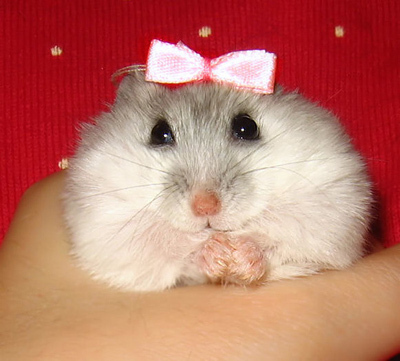
Tiny cute Hamster
Wednesday, 24 July 2013
GoT Smile
 Hamsters are rodents belonging to the subfamily Cricetinae. The subfamily contains about 25 species, classified in six or seven genera.[1]
Hamsters are rodents belonging to the subfamily Cricetinae. The subfamily contains about 25 species, classified in six or seven genera.[1]
Hamsters are crepuscular and remain underground during the day to avoid being caught by predators. In the wild, they feed primarily on seeds, fruits, and vegetation, and will occasionally eat burrowing insects.[2] They have elongated cheek pouches extending to their shoulders in which they carry food back to their burrows.
Hamster behavior varies depending on their environment, genetics, and interaction with people. Because they are easy to breed in captivity, hamsters are often used aslaboratory animals. Hamsters have also become established as popular small housepets,[3] and are sometimes accepted even in areas where other rodents are disliked, and their typically solitary nature can reduce the risk of excessive litters developing in households.
My Hamster LiL Cutie
 Hamsters are rodents belonging to the subfamily Cricetinae. The subfamily contains about 25 species, classified in six or seven genera.[1]
Hamsters are rodents belonging to the subfamily Cricetinae. The subfamily contains about 25 species, classified in six or seven genera.[1]
Hamsters are crepuscular and remain underground during the day to avoid being caught by predators. In the wild, they feed primarily on seeds, fruits, and vegetation, and will occasionally eat burrowing insects.[2] They have elongated cheek pouches extending to their shoulders in which they carry food back to their burrows.
Hamster behavior varies depending on their environment, genetics, and interaction with people. Because they are easy to breed in captivity, hamsters are often used aslaboratory animals. Hamsters have also become established as popular small housepets,[3] and are sometimes accepted even in areas where other rodents are disliked, and their typically solitary nature can reduce the risk of excessive litters developing in households.
Lovable Hamster

 Hamsters are rodents belonging to the subfamily Cricetinae. The subfamily contains about 25 species, classified in six or seven genera.[1]
Hamsters are rodents belonging to the subfamily Cricetinae. The subfamily contains about 25 species, classified in six or seven genera.[1]
Hamsters are crepuscular and remain underground during the day to avoid being caught by predators. In the wild, they feed primarily on seeds, fruits, and vegetation, and will occasionally eat burrowing insects.[2] They have elongated cheek pouches extending to their shoulders in which they carry food back to their burrows.
Hamster behavior varies depending on their environment, genetics, and interaction with people. Because they are easy to breed in captivity, hamsters are often used as laboratory animals. Hamsters have also become established as popular small house pets,[3] and are sometimes accepted even in areas where other rodents are disliked, and their typically solitary nature can reduce the risk of excessive litters developing in households.
Cute Girl Hamter
 Hamsters are rodents belonging to the subfamily Cricetinae. The subfamily contains about 25 species, classified in six or seven genera.[1]
Hamsters are rodents belonging to the subfamily Cricetinae. The subfamily contains about 25 species, classified in six or seven genera.[1]
Hamsters are crepuscular and remain underground during the day to avoid being caught by predators. In the wild, they feed primarily on seeds, fruits, and vegetation, and will occasionally eat burrowing insects.[2] They have elongated cheek pouches extending to their shoulders in which they carry food back to their burrows.
Hamster behavior varies depending on their environment, genetics, and interaction with people. Because they are easy to breed in captivity, hamsters are often used aslaboratory animals. Hamsters have also become established as popular small housepets,[3] and are sometimes accepted even in areas where other rodents are disliked, and their typically solitary nature can reduce the risk of excessive litters developing in households.
HungRy Hamster

Hamsters belong to the rodent group of mammals. Like all mammals, they are warm-blooded and have a hairy skin. Females give birth to live young and feed them on their own milk. Rodents make up more than 50 percent of all the species of mammal. They are named after the Lain word rodere, meaning "to gnaw." This is because all rodents have one pair of upper incisor teeth and one pair of lower incisor teeth at the front of their mouth. These grow continually and wear against each other as they gnaw at their food. Rodents range in size from the tiny Old World harvest mouse at around four grams to the South American capybara at a massive 88 lbs. about ten thousand times heavier!
|
Subscribe to:
Comments (Atom)
